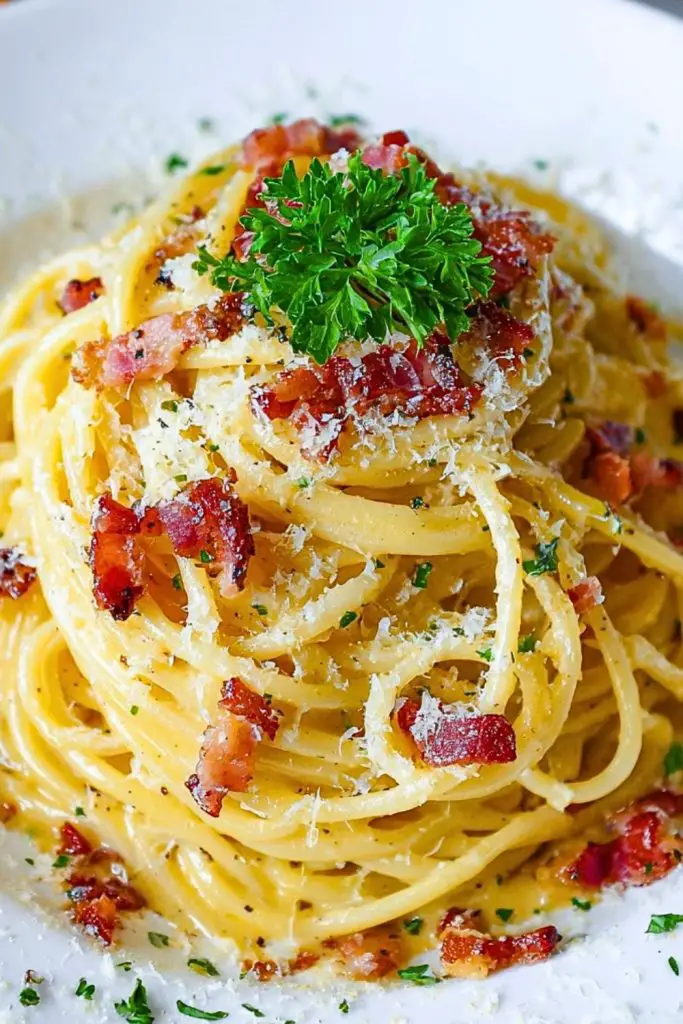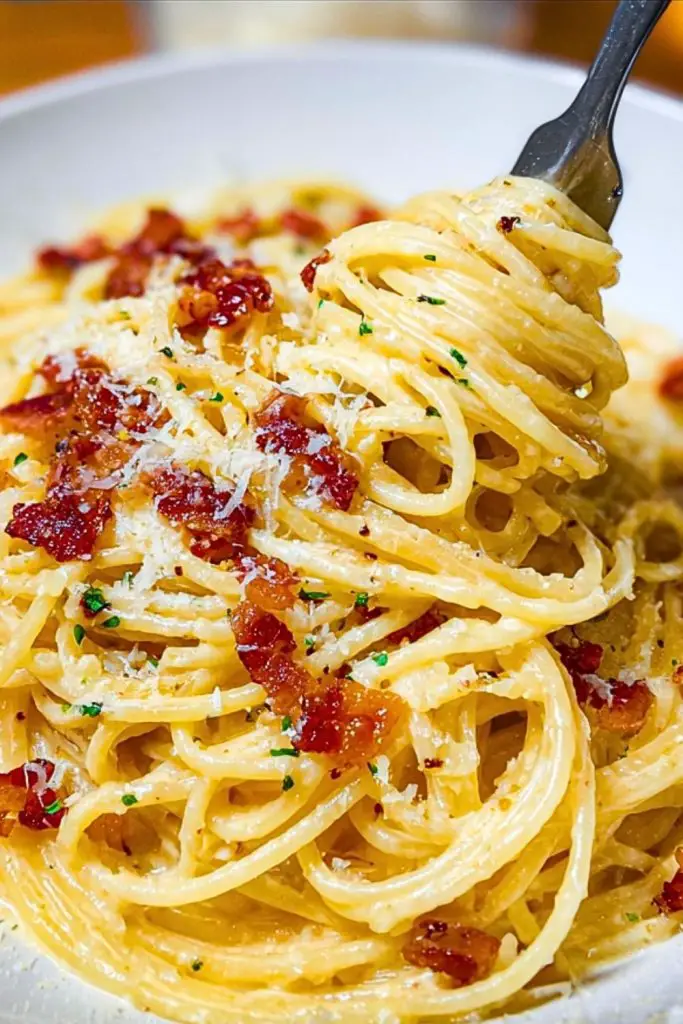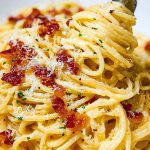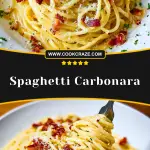I’ve always had a deep appreciation for recipes that feel luxurious yet come together with a few simple ingredients. That’s why Spaghetti Carbonara is one of my go-to dishes. It’s rich, creamy (without using cream!), and every bite delivers a comforting mix of salty pancetta, sharp cheese, and silky pasta coated in an egg-based sauce that’s nothing short of magic. Whenever I make it, the aroma alone is enough to draw everyone to the table—no need to call anyone twice.

I’ve experimented with different versions of carbonara, but I always come back to the classic Roman approach. It’s a lesson in how just a handful of quality ingredients can transform into something unforgettable. Whether you’re making dinner for one or hosting friends, this dish hits the mark every single time.
Why You’ll Love This Spaghetti Carbonara
Spaghetti Carbonara delivers bold flavors with minimal fuss. It uses pantry staples and doesn’t require fancy techniques, making it approachable for any home cook. The result is a creamy pasta dish that feels indulgent without needing heavy cream or a long list of ingredients. If you love quick recipes that taste like they came from a restaurant kitchen, this one deserves a spot in your rotation.
What Type of Pasta Works Best for Spaghetti Carbonara?
Traditionally, carbonara is made with spaghetti—hence the name Spaghetti Carbonara—but you’re not limited to just that. I love how spaghetti allows the sauce to cling beautifully to every strand, delivering a silky bite each time. But if you don’t have spaghetti on hand, bucatini or linguine also work well due to their similar shape and texture. Even rigatoni or penne can be used if you’re looking for something heartier; they trap the sauce and pancetta in every bite. The key is using pasta that offers a good surface area to coat with the eggy, cheesy goodness.
Options for Substitutions
Even though Spaghetti Carbonara relies on a few specific ingredients, you can still make some smart substitutions without losing its soul:
- Pancetta or Guanciale: Guanciale is the traditional choice, but pancetta or even thick-cut bacon makes a great substitute if that’s what you have.
- Pecorino Romano: This is the go-to cheese in authentic recipes, but Parmesan works well if you prefer a milder, nuttier flavor.
- Spaghetti: As mentioned, feel free to use linguine, bucatini, or even short pasta like rigatoni.
- Egg Yolks: Some recipes use whole eggs, but I like using more yolks for a richer sauce. If you want it lighter, go half yolks, half whole eggs.
- Black Pepper: Freshly cracked black pepper is essential for that signature carbonara kick—but you can play with pink or white peppercorns for a twist.
With these swaps, you can tailor the dish to what’s in your fridge or your personal preferences—without straying too far from the classic comfort of Spaghetti Carbonara.
Ingredients for This Spaghetti Carbonara
- Spaghetti
This is the heart of the dish. Long, thin strands are perfect for holding the creamy sauce and letting the flavors cling to every bite. - Guanciale (or Pancetta)
This cured pork provides a salty, rich, and slightly chewy contrast to the smooth pasta. Its rendered fat adds depth and richness to the sauce. - Egg Yolks
They create the luxurious, silky texture that carbonara is famous for. Egg yolks emulsify with the cheese and pork fat to form the creamy sauce—no cream needed. - Pecorino Romano
Sharp, salty, and slightly tangy, this cheese brings a punch of umami to the dish. It melts into the eggs to give the sauce its signature body. - Freshly Cracked Black Pepper
Adds warmth and a little kick that balances the richness of the cheese and egg. - Salt
Used sparingly to season the pasta water—since the guanciale and cheese already bring plenty of salt to the table.
These six ingredients are all you need to make an unforgettable plate of Spaghetti Carbonara. Keep it simple, and let each component shine.

Step 1: Boil the Pasta
Bring a large pot of salted water to a boil and cook the spaghetti until just shy of al dente. Reserve about a cup of pasta water before draining—it will help adjust the sauce later.
Step 2: Cook the Guanciale
In a large skillet over medium heat, cook the guanciale (or pancetta) until it’s golden and crisp. This takes about 5–7 minutes. Remove from heat but keep the rendered fat in the pan—it’s liquid gold for the sauce.
Step 3: Whisk the Sauce
While the pasta is cooking, whisk the egg yolks with grated Pecorino Romano and a generous amount of freshly cracked black pepper in a mixing bowl. The mixture should be thick and creamy.
Step 4: Combine Everything Off the Heat
Add the drained pasta to the skillet with the guanciale and fat—off the heat to prevent scrambling the eggs. Quickly pour in the egg and cheese mixture, tossing vigorously to coat the pasta. Add splashes of reserved pasta water a little at a time to loosen the sauce and make it glossy.
Step 5: Serve Immediately
Plate the pasta while it’s hot, sprinkle with extra cheese and pepper, and serve right away. Garnish with parsley if you like a pop of color, but traditionally, it’s not necessary.
How Long to Cook the Spaghetti Carbonara
The whole dish comes together in about 25 minutes:
- Pasta Cooking Time: 8–10 minutes, depending on the brand and your preferred doneness.
- Guanciale Cooking Time: 5–7 minutes to get it crisp and golden.
- Sauce Assembly: 3–5 minutes once everything is combined.
Since it’s a fast-moving recipe, it’s best to prep all your ingredients beforehand. Timing is key to ensure the eggs don’t scramble and everything stays silky and smooth.
Tips for Perfect Spaghetti Carbonara
- Use Room-Temperature Eggs: Cold eggs can seize up and scramble when they hit the warm pasta. Let them sit out while the pasta cooks.
- Don’t Add Heat After Mixing: Once the eggs and cheese go in, keep the pan off the burner. Residual heat is all you need to create that creamy sauce.
- Reserve Pasta Water: The starchy water is essential for adjusting the sauce’s texture. Don’t forget it!
- Toss Vigorously: Mixing the pasta with the sauce quickly and evenly helps emulsify the fat and eggs into a smooth coating.
- Grate the Cheese Freshly: Pre-grated cheese doesn’t melt as well and can clump. Use a microplane or fine grater for best results.
- Serve Immediately: Carbonara doesn’t wait. It’s best enjoyed fresh off the stove, before the sauce thickens too much.
Watch Out for These Mistakes While Cooking
- Adding Eggs Over Direct Heat: This is the most common mistake. If the pan is still on the burner, the eggs will scramble. Always remove it from heat before mixing.
- Using Cream: Traditional carbonara doesn’t contain cream. The creamy texture comes from eggs, cheese, and pasta water. Adding cream dulls the flavor and authenticity.
- Overcooking the Guanciale: You want it crisp but not burned. Burnt guanciale will turn bitter and ruin the dish’s balance.
- Not Using Enough Pepper: Carbonara should have a noticeable black pepper kick—it’s one of the core flavors.
- Skipping the Pasta Water: Without it, the sauce won’t achieve the right consistency. A splash or two goes a long way.
What to Serve With Spaghetti Carbonara?
Garlic Bread
Crispy, buttery garlic bread is perfect for mopping up any leftover sauce on the plate.
Arugula Salad
A light salad with lemon vinaigrette balances the richness of the carbonara with a peppery, citrusy bite.
A Glass of Dry White Wine
Something like Pinot Grigio or Vermentino cuts through the richness and complements the cheese and pork.
Antipasto Platter
Before the main course, serve a small plate of olives, marinated artichokes, and cured meats for an Italian vibe.
Grilled Asparagus
Bright, slightly charred asparagus with a squeeze of lemon brings freshness to the meal.
Sautéed Mushrooms
Earthy mushrooms sautéed in butter and herbs add a savory side that pairs beautifully with carbonara’s richness.
Roasted Cherry Tomatoes
Sweet and slightly caramelized, they provide a juicy contrast to the salty elements of the dish.
Storage Instructions
Spaghetti Carbonara is at its best when served fresh, but if you have leftovers, store them properly to preserve as much of that creamy texture as possible:
- Refrigerate: Let the pasta cool completely, then transfer to an airtight container. It will keep in the fridge for up to 3 days.
- Reheat Gently: Reheat in a nonstick skillet over low heat, adding a splash of water or milk to loosen the sauce. Avoid the microwave—it can make the eggs rubbery.
- Don’t Freeze: Carbonara doesn’t freeze well due to the egg-based sauce, which tends to separate and become grainy once thawed.
Estimated Nutrition (Per Serving – based on 4 servings)
- Calories: 580
- Total Fat: 28g
- Saturated Fat: 10g
- Cholesterol: 220mg
- Sodium: 720mg
- Carbohydrates: 58g
- Fiber: 2g
- Sugar: 2g
- Protein: 23g
Keep in mind these values can vary depending on the ingredients used (e.g., using pancetta vs. guanciale, or Pecorino vs. Parmesan).
Frequently Asked Questions
What’s the difference between guanciale and pancetta?
Guanciale is made from pork jowl and has a richer, more delicate flavor than pancetta, which comes from pork belly. Guanciale also renders more fat, giving carbonara its signature depth. Pancetta is easier to find and works well as a substitute.
Can I make Spaghetti Carbonara without eggs?
If you remove the eggs, it’s no longer a true carbonara—but you can create a creamy pasta using substitutes like ricotta, mascarpone, or even a béchamel sauce. Just know it won’t have the same flavor or texture.
Why did my sauce turn into scrambled eggs?
The sauce likely cooked too quickly or was mixed in while the pasta or pan was too hot. Always take the pan off the heat before adding the egg mixture, and stir fast and continuously.
Is it safe to eat the eggs in carbonara?
Yes, the residual heat from the pasta cooks the eggs gently to a safe temperature. If you’re concerned, you can use pasteurized eggs.
Can I use whole eggs instead of just yolks?
Absolutely. Whole eggs create a slightly lighter sauce. I like using one whole egg plus extra yolks for richness and balance.
What can I do if my sauce is too thick?
Add more reserved pasta water, one tablespoon at a time, and keep tossing until the sauce is silky and smooth again.
Can I make this dish vegetarian?
You can skip the guanciale and add sautéed mushrooms or smoked paprika for a hint of depth. It won’t be traditional, but still delicious.
Is Carbonara supposed to have garlic or onions?
Nope. Classic carbonara contains no garlic, no onions, and definitely no cream. It’s all about the eggs, cheese, pepper, and pork.
Conclusion
Spaghetti Carbonara is proof that simplicity wins. With just a handful of ingredients and a few mindful steps, you can create a dish that’s rich, comforting, and timeless. Whether you’re cooking for a weeknight dinner or an intimate gathering, this recipe brings both elegance and ease to the table. Once you’ve mastered it, you’ll find yourself coming back to it again and again—for its flavor, its simplicity, and the pure pleasure of making something so good with so little.

Spaghetti Carbonara
- Total Time: 25 minutes
- Yield: 4 servings
Description
A classic Roman pasta that comes together in under 30 minutes with just six ingredients. Silky, rich, and savory, Spaghetti Carbonara is the ultimate comfort dish without the need for cream. Perfect for any day of the week, it’s a crowd-pleaser made with pantry staples.
Ingredients
400g spaghetti
150g guanciale (or pancetta)
4 large egg yolks
1 whole egg
80g Pecorino Romano cheese, finely grated
1 tsp freshly cracked black pepper
Salt, to taste
Instructions
1. Bring a large pot of salted water to a boil and cook the spaghetti until just under al dente. Reserve 1 cup of pasta water before draining.
2. While the pasta cooks, cut the guanciale into small strips and cook in a skillet over medium heat until crisp and golden, about 5–7 minutes. Remove from heat.
3. In a bowl, whisk together the egg yolks, whole egg, Pecorino Romano, and black pepper until smooth and creamy.
4. Add the drained pasta to the pan with guanciale and its fat (off the heat). Pour in the egg and cheese mixture, stirring vigorously to coat the pasta evenly.
5. Gradually add reserved pasta water, a tablespoon at a time, until the sauce reaches a glossy, silky consistency.
6. Plate immediately, topped with extra cheese and black pepper if desired.
Notes
Prep time: 10 minutes
Cook time: 15 minutes
Total time: 25 minutes
Yield: 4 servings
Category: Pasta
- Prep Time: 10 minutes
- Cook Time: 15 minutes
- Category: Pasta
- Method: Stovetop
- Cuisine: Italian
Nutrition
- Serving Size: 1 plate
- Calories: 580
- Sugar: 2g
- Sodium: 720mg
- Fat: 28g
- Saturated Fat: 10g
- Unsaturated Fat: 14g
- Trans Fat: 0g
- Carbohydrates: 58g
- Fiber: 2g
- Protein: 23g
- Cholesterol: 220mg
Keywords: carbonara, spaghetti, pasta, Italian classic

